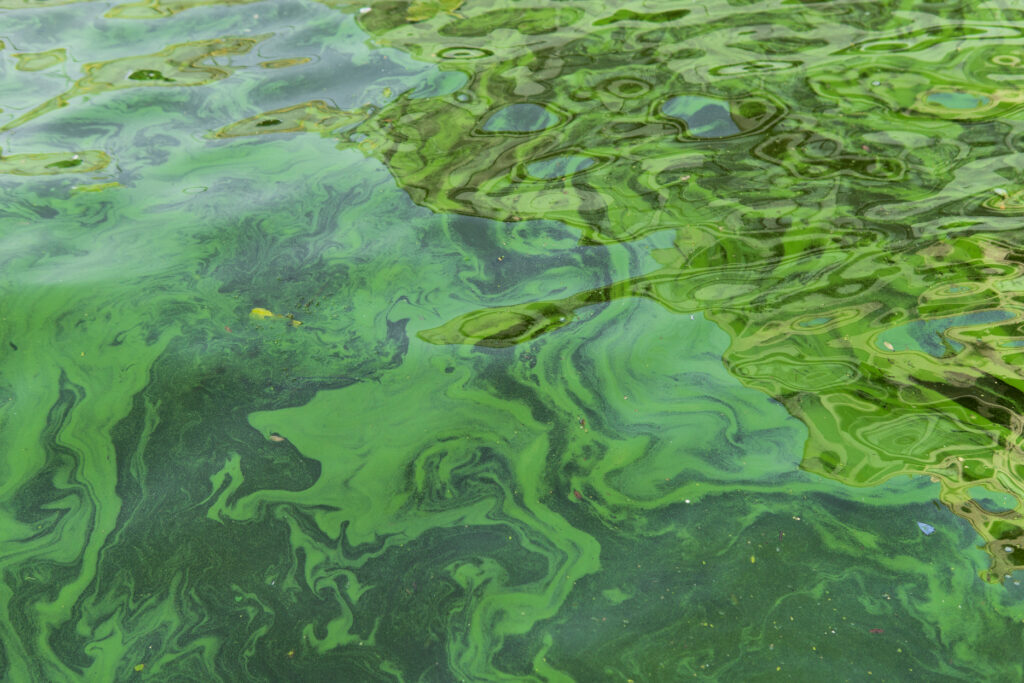Cyanobacteria – sometimes called blue-green algae, though they aren’t algae – are often toxic. (Getty Images)
While bloom notices piled up ahead of Labor Day weekend, Gov. Chris Sununu claimed at an Executive Council meeting held in Wakefield last week that cyanobacteria are “not toxic.” But scientists have found that cyanobacteria, especially blooms, frequently produce toxins.
“This is not toxic. This does not kill people,” Sununu said to Robert Scott, commissioner of the Department of Environmental Services. “Right? That’s not what this issue is. I think some dogs, I think they’ve been warned that … dogs shouldn’t eat it or something like that if they’re in the water.”
“Please make sure that people understand this is not some deadly bacterial bloom that should shut down beaches or anything like that,” Sununu told the commissioner. He said cyanobacteria was “a yucky, slimy thing” but that the department’s messaging on the issue was “terrible.”
On Sununu’s claim that cyanobacteria aren’t toxic: “That’s wrong,” said Jessica Volan Trout-Haney, an aquatic ecologist at Dartmouth who studies cyanotoxins. “… There are, you know, occasionally species that don’t produce toxins, but almost every time we measure for cyanotoxins in bloom conditions, they are present. So if there are cyanobacteria there, they’re almost always producing toxins. It’s very consistent.”
Cyanotoxins, of which there are different kinds, can cause rashes, fevers, headaches, mouth blisters, vomiting, acute liver damage, and more, according to DES, and “long-term exposure can harm the liver and central nervous system.” They can also kill pets.
Trout-Haney said that “almost every strain or species of cyanobacteria produces cyanotoxins.” The level of those toxins varies, she said, and cyanobacteria produce more toxins when blooming. These toxins cannot be detected by the eye; there must be testing to know if they’re present.
On its Healthy Swimming Mapper, where it tracks cyanobacteria blooms and fecal bacteria, DES “advises lake users to avoid contact with the water in the vicinity of areas experiencing blooms” and keep pets and livestock out of the water. Sununu’s frustration with DES was voiced in a conversation about a bloom on Lake Winnipesaukee, as first reported by InDepthNH.org.
“When the state is putting out these alerts, that is because there’s bloom conditions; it’s above a certain threshold that’s deemed safe,” Trout-Haney said. “And that’s based on the studies that we’ve conducted that look at cyanotoxin production with growth. So when there’s a bloom, that means there’s a lot of growth, and that means there’s more toxins, and they’re also generally producing more than one type of toxin.”
While cyanobacteria play an important role in ecosystems, according to the U.S. Environmental Protection Agency, “excessive growth of cyanobacteria can lead to ‘blooms’ that can cause ecological and human health concerns.”
“Some cyanobacteria are able to produce highly potent toxins, known as cyanotoxins, that can lead to a variety of health problems for both human and aquatic species,” the agency said, pointing to examples such as “abdominal, neurological, and skin issues.”
There is still much to learn about the impact of cyanobacteria on human health, said Kathryn L. Cottingham, a Dartmouth professor and researcher.
What we do know, she said: “We know that some cyanobacteria produce toxins, that some of those toxins accumulate in our livers and cause cancers, that some of those toxins are neurotoxins that can impact our brains, and that it’s really hard to know just looking at something what’s happening with the toxins.”
How to stay safe
Some activities pose more risks than others. Direct contact with the bloom and ingesting that water, such as through swimming, are the main things to avoid, Trout-Haney said.
“I take the precautionary principle,” Cottingham said. “If I see a bloom, I want to stay out of it. I want to keep my dog out of it.”
“Every year, there are pets that do die from ingesting cyanobacteria toxins,” Trout-Haney said. Pets can drink the water while swimming in a bloom or lick harmful toxins off of themselves when they come out of the water, she said.
People with compromised immune systems, children, and older people are more at risk, she said.
Shallow areas of the water tend to be less safe, Trout-Haney said, because it’s warmer and there’s less mixing. Cyanobacteria thrive in warm, sunny, nutrient-rich environments. Often, there are blooms on the shore of the lake, but the middle of the water body is clear, she said.
“If you’re driving your boat through a bloom, that’s probably fine,” Trout-Haney said, but “it’s probably wise to minimize your time right in that bloom area, and go to an area that is less bloom heavy.”
As for other activities, “if you are spending a lot of time right next to a bloom, there’s a possibility that you’re inhaling cells. We measure cells coming out of the water and into the air pretty regularly,” she said. “But how much of an impact that actually has on your long term health? You know, that’s where … there’s a lot still unknown.”
And for anglers, “the safest thing to do is if you’re in a big bloom area … (is) move outside of that area to collect fish that you’re going to consume,” Trout-Haney said.

